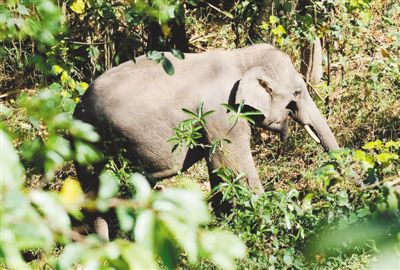A human-made canteen for wild elephants

An Asian elephant in Xishuangbanna, Yunnan Province Photo: XINHUA
Elephant habitats have shrunk for hundreds of years due to human encroachment, displacing China’s last remaining Asian elephants to the forested area in southwestern Yunnan Province. In 1958, China established a natural conservation zone in Xishuangbanna, where governments adopted rescue and protection measures when wild Asian elephants were on the edge of dying off within the country.
“At that time, there were vast forests and sufficient food for wild Asian elephants to survive. Local governments didn’t restrict the scope of elephants’ activities, even though the animals sometimes raided crops in villages. Instead, they resettled the farmers living within the conservation zone and compensated the farmers on the zone brink, thus seeking a harmonious human-elephant relationship,” said Chen Mingyong, director of the Research Center for Asian Elephants at Yunnan University. However, land development in the tropical area became prevalent and the tropical forests outside the conservation zone gave way to cash crops, such as rubber and tea. Asian elephants didn’t eat these cash crops, making the dense artificial vegetation no more than a green desert.
The consistent conservation led to a growth in the elephant population. Also, forests replaced the wasteland, grasslands and sparser forests within the protected zone, leaving fewer choices and lower quantities for the wild elephants’ diet. More elephants were forced to wander into villages due to a lack of food, and they started to eat crops. Villagers had a fear of elephants because elephant attacks caused many human injuries and deaths. The wild animal, normally considered by local people an auspicious symbol, became a source of bitterness.
The human-elephant conflict became a challenge for Asian elephant conservation. Since 2000, Xishuangbanna Prefecture has grown a food base area for wild elephants within the conservation zone as a solution to the problem. This human-made “elephant canteen” expanded to nearly 700 square kilometers, attracting wild elephants as well as other species such as Indian bison, sambars, scorpions and macaques.
Initially, the base mainly had corn and sugar cane, but Guo Xianming, a senior engineer of the Management Bureau of Xishuangbanna Conservation Zone, found that “the elephants have changed their eating habit from the consumption of wild plants to a preference for crops.”
Starting in 2007, the canteen no longer grew crops, instead retaining the edible plants that were previously distributed in the area. It also grew more other fodder that elephants like, such as wild bananas and tiger grass.
No statistics indicate that the food base has reduced the frequency of crop raiding incidents, Guo said, but we have detected elephant presence in new areas, suggesting the expansion of wild elephant foraging. This has alleviated the human-elephant conflict.
However, the canteen supplies a limited amount of food. In his research, Chen found that a male adult wild elephant consumes more than 200 kilograms of food each day when it has a good appetite. “Over 240 varieties of wild plants and human-grown crops are elephant delicacies. Wild elephants eat rice and corn in farmlands, and they eat bananas and eucalyptus leaves in the wild,” Chen said.
In fact, wild elephants may not prefer the canteen even if it did have sufficient food. Certain sections of farmland near the food base have been more attractive to them. “Crops have advantages in terms of taste, nutrients and yield. The canteen has failed to keep wild elephants from eating crops,” Chen said, arguing that the food base is not an effective solution to the human-elephant conflict caused by foraging, even though it does attract groups of elephants.
Also, the food base faces barriers in manpower and material resources, especially when it comes to funding. “There is no particular funding project. The operation is reliant on governments, companies and social organizations. It is difficult to continue the conservation work without funds,” Guo said. He suggested expanding the canteen’s area and planting more food in a bid to reduce crop destruction.
Traces of wild elephant activity are scarce within the conservation zone in Xishuangbanna. Some experts have proposed a new elephant food base at the core of the zone to draw the wild elephants back into the deep forests. But such advice runs contrary to current legal provisions that only permit approved observational research activities and prohibit the destruction of native trees.
“Apart from protection, wildlife management also matters. In the future, people should improve management efforts to reduce elephant attacks and destruction,” Chen said. Both humans and elephants need protection. He proposed pilot projects in the area where wild elephants often appear and leaving ample land for new protected area. Also, local villagers should separate their living space from the activity scope of wild elephants. In addition, the artificial regeneration and supplementary cultivation of elephant-diet plants will enable a better elephant habitat that meets elephants’ survival needs and ensures their population growth. This proposal, in accordance with existing law, could help avoid human-elephant conflict more effectively.
This article was translated from People’s Daily.
(edited by MA YUHONG)
